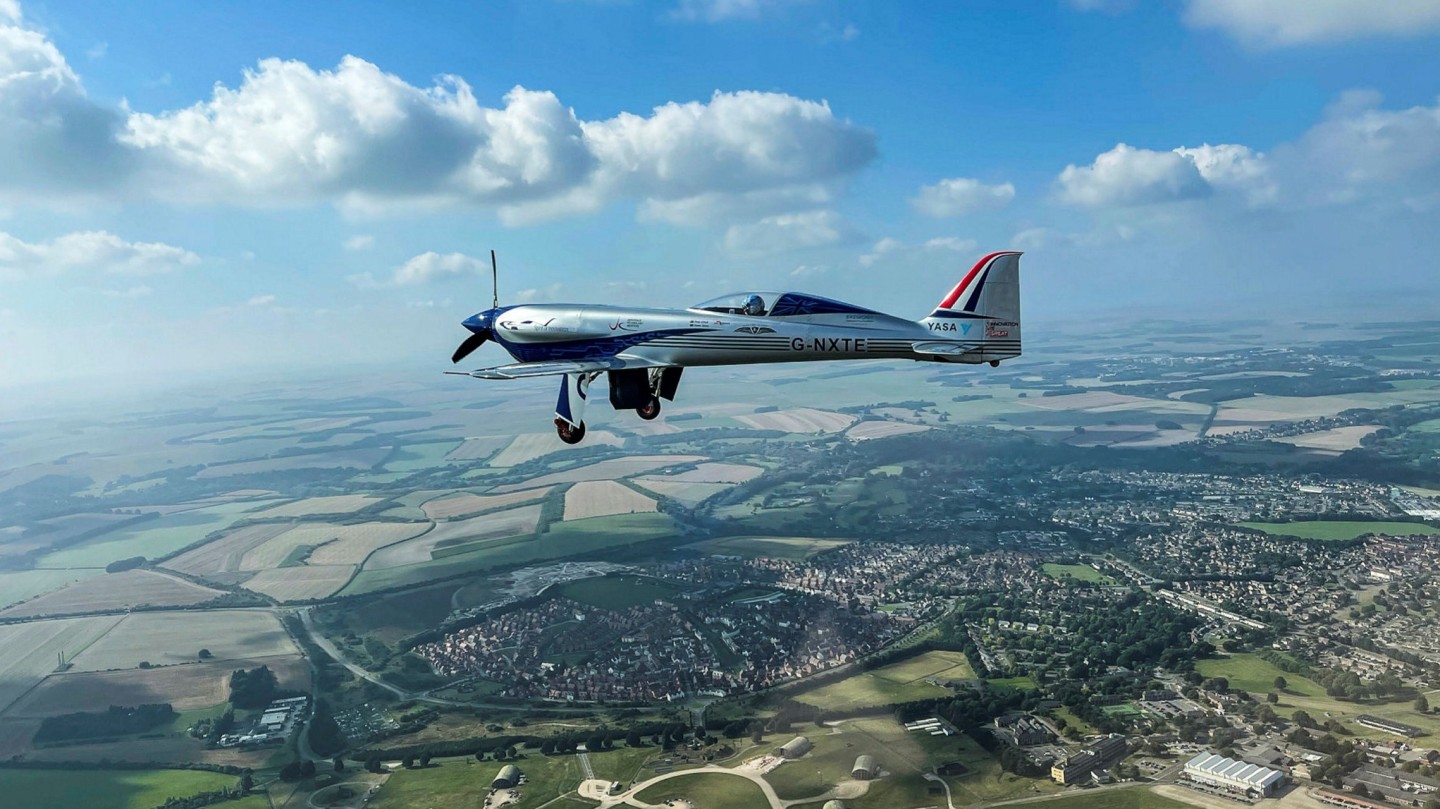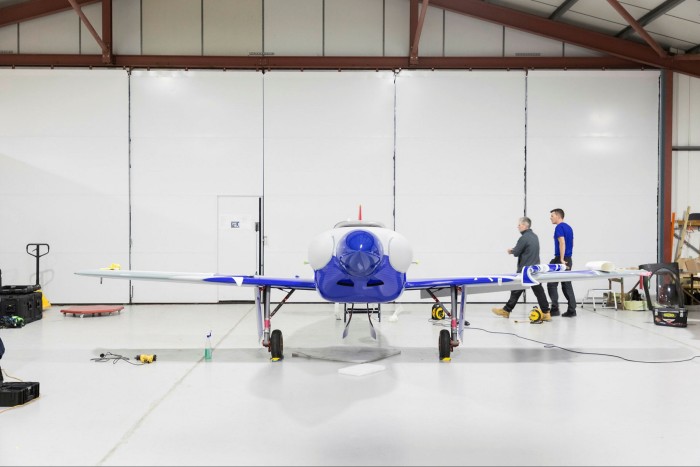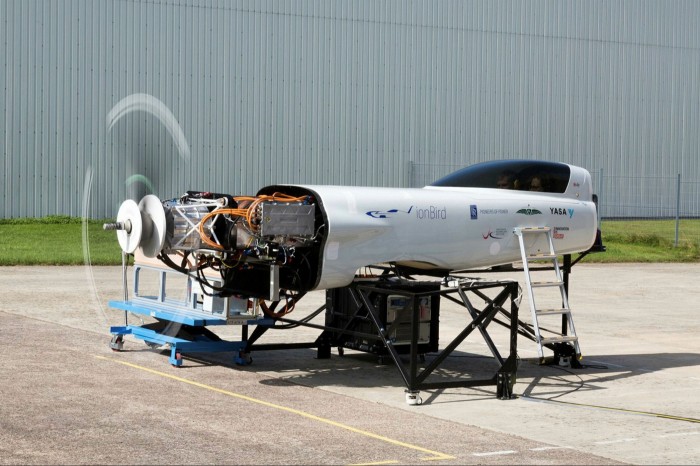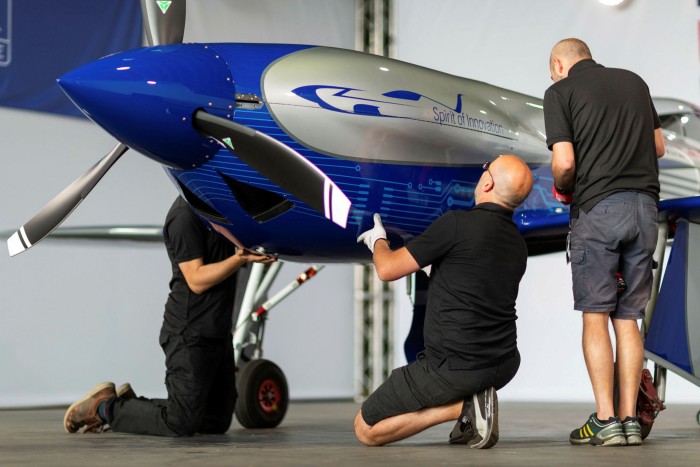Rolls-Royce sets course to net zero after Covid turbulence

Roula Khalaf, Editor of the FT, selects her favourite stories in this weekly newsletter.
On a bright afternoon in September, a small silver and blue aircraft took off from Boscombe Down, the military airfield near Stonehenge that has been the site of many famous maiden flights.
This was no exception — the single-seater was electrically powered and carried the hopes of its developer, Rolls-Royce, eventually to bring a battery-powered aircraft to market.
With 6,000 battery cells and three motors delivering more than 500 horsepower, Spirit of Innovation (pictured above) will soon be aiming for an air speed world record for electric aircraft. But it is not just about chasing records; the aircraft is the most eye-catching example of the FTSE 100 company’s focus on developing technology breakthroughs that could transform commercial aviation.
The programme has echoes of one of the company’s most-celebrated episodes, when Rolls-Royce developed the Type R engine. It powered airspeed racers in the 1930s and was the precursor to the Merlin engine used in the Spitfire fighter during the second world war.
Spirit of Innovation is a “mixture of history, inspiring the young, showing that electric flight is real and setting the pathway for a set of products that will make electric flight a reality”, says Paul Stein, Rolls-Royce’s chief technology officer.
Like other aerospace companies, the aero-engine group must navigate the world’s transition to net zero. Warren East, Rolls-Royce chief executive, has pledged to make all commercial engines in production able to run on 100 per cent sustainable aviation fuel by 2023. The company says it will achieve net zero emissions by 2050.

There is much at stake. Rolls-Royce is only just emerging from the depths of the coronavirus pandemic. The collapse in long-haul air travel led to a grounding of the large aircraft that use the company’s engines, slashing its revenues. Before the crisis, about half of Rolls-Royce’s then £15.4bn in annual underlying revenues came from its civil aerospace division. Investors, including Causeway Capital Management, are watching closely how the company manages the transition.
The pressure to curb emissions has only increased since the crisis and aerospace companies are working on several different technologies. One of the challenges for the industry, according to Nick Cunningham, an analyst at Agency Partners in London, is that, as yet, “nobody knows” how big the coming changes will be.
“It’s a bit like cars in the early 1900s or the transition to jets in the 1940s. We’re at a cusp of a shift in technology, but the various alternatives are so radically different that it is difficult to divine a winner,” he says.

Rolls-Royce, he adds, is “very good at aerodynamics and combustion, but combustion is the problem, so finding its position in the new world will not be easy”.
Company executives argue that despite the damage wrought by the pandemic, the group is well positioned to turn the decarbonisation challenge into a commercial opportunity. Its interests in electric aircraft, sustainable aviation fuels, mini nuclear reactors and power-systems management mean it is more than just a maker of gas turbines that burn fossil fuels, executives say.
To achieve its climate targets, the company plans to focus 75 per cent of its research and development spending on lower-carbon and net zero technologies by 2025 — up from about 50 per cent today. It typically spends more than £1bn annually on R&D, although that figure fell in 2020 during the pandemic.
Stein says the company invests its budget broadly in “three buckets”: “sustaining engineering”, focused on improving existing products; making products compatible with a net zero world; and new directions that have arisen through net zero.
In aviation, the focus is on how to decarbonise the group’s powerful gas turbines. According to Stein, the answer for long-haul aviation is sustainable aviation fuels (SAFs). “We won’t be flying battery aeroplanes across the Atlantic. For the next 40 or 50 years, for long-haul aviation, [we are looking at] very efficient gas turbines powered by SAFs,” he says.
The company believes that for short-range flights, of between 100 and 300 miles, battery power will allow for the transport of between four and 19 passengers, depending on the configuration of the aircraft. The company has partnered with air taxi company Vertical Aerospace and is working with the Norwegian regional airline Wideroe to develop an all-electric passenger aircraft.


Rolls-Royce is working on a range of technologies, including turbo-electric and hydrogen, to address the midsized market segment between long-range and short-range. The lessons that Stein and his engineers are drawing from the process will be applied across the group, including work by Rolls-Royce’s defence business to develop a propulsion system for Britain’s next-generation Tempest fighter jet.
To make its bet on SAFs a reality, Rolls-Royce is partnering with other companies, including oil major Shell. Among the challenges are a shortage of sustainable fuels and their cost — they are up to five times more expensive than current jet fuel, though executives think it should be possible to drive that down to two times the cost within a decade. Rolls-Royce believes the aviation industry will need 500m tonnes of the fuels annually by 2050.
Stein is optimistic that, despite the size of the challenge, the need “will create huge amounts of innovation”, adding that “there is a danger of taking a 2021 optic of where technology can take us”.

One of the most exciting areas for the group is its investment in small modular reactors (SMRs), which could, if successful, provide it with an important new revenue stream and cut its exposure to commercial aerospace. Rolls-Royce is leading a consortium, which also includes engineering groups Jacobs and Laing O’Rourke, that hopes to be the first mini-reactor developer to put its design through the UK’s nuclear regulatory assessment. Boris Johnson, UK prime minister, backed SMRs as part of his 10-point plan for a “green industrial revolution” last year. The hope is that they will cut the cost of nuclear power and help the UK meet its target of net zero emissions by 2050.
Rolls-Royce, which has been working on SMRs since 2015, expects a sizeable market for its reactors, with 470MW plants costing £2.2bn, dropping to £1.8bn for subsequent units. If successful, they could help power large-scale data centres and provide grid-based energy.
The company is also considering using the energy from these small reactors to help make sustainable aviation fuels by the mid-2030s. Its engineers have also teamed up with the UK Space Agency to study how power from micronuclear reactors could be used in space.
Not everyone is convinced, however, that mini reactors will become a commercial reality. Critics point that there are few, if any, operating in the world. Environmental campaigners also point to the problem that nuclear energy leaves behind a legacy of waste. Irrespective of the technical challenges involved, there will come a point for Rolls-Royce when the company will have to persuade investors that it can make money from its push into small-scale nuclear and electric flight. It has promised to provide financial details of the potential scale of the businesses alongside its full-year results early next year. This will also give the market a clearer picture of the health of its balance sheet after the pandemic.
Some investors also remain to be convinced that Rolls-Royce’s power systems business is core to the group and that it is indeed becoming more of an evenly spread business. But Stein is adamant: “Rolls-Royce is becoming, bit by bit, a more balanced business across land- and sea-based power generation and aviation. We are a power propulsion company.”
* This article has been amended since original publication to remove an incorrect reference to the Spitfire as a jet. This was due to an editing error.
Twice weekly newsletter
Energy is the world’s indispensable business and Energy Source is its newsletter. Every Tuesday and Thursday, direct to your inbox, Energy Source brings you essential news, forward-thinking analysis and insider intelligence. Sign up here.
Comments